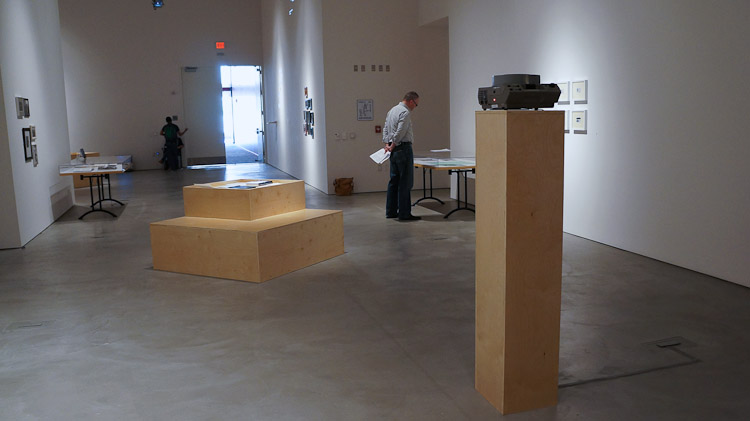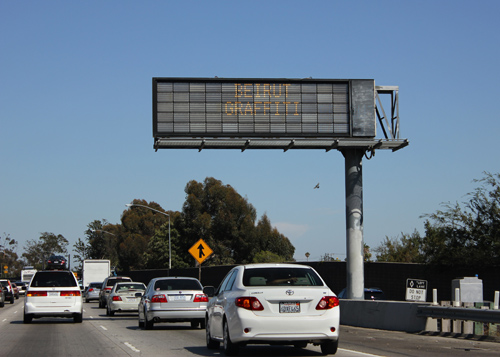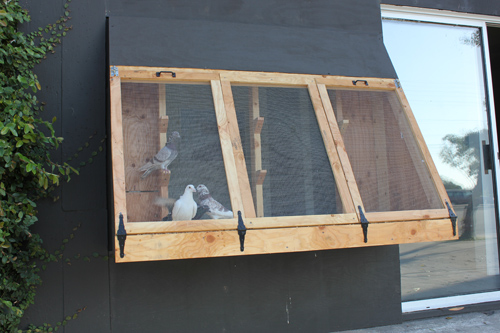Google “Art” and “Lie” together and the first thing that comes up is the Picasso quote: “We all know that art is not truth. Art is a lie that makes us realize truth.” But a lot of us also know that it’s usually not so clear exactly what truth an art lie has made us realize. The art-lie-truth triangle is a gray area.
Here’s a story about that gray area that starts with pigeons:
Most homing and racing pigeons in L.A. live on the eastside, maybe because eastside neighbors are less likely to complain about hodge-podge lofts built in backyards. Or maybe it’s just easier to control pigeon loft humidity when you’re further from the ocean.
Whatever the reason, an eastside pigeon loft was what artist Seth Weiner and artist-curator Sergio Bromberg wanted when they went pigeon-hunting this summer. Particularly, they wanted birds that would fly east along the I-10 when released from the Pacific Coast Highway. They found a loft in Alhambra, run by a man who motivates his racing pigeons by placing squirming crickets inside eggs they’ve been sitting on, so they’ll fly as fast as possible to get home before their chicks hatch. Its location was perfect.
The birds would be part of Weiner’s “Twitter Pigeon” project, an idea he began toying with around 2008, when Twitter was playing into its first-ever presidential election and optimism about its message-carrying potential swelled. Weiner had done some research into freeway sign hacking–people had done it, reprogramming those LED boards that usually say things like “20 minutes to downtown” or “405 closed ” to say brainless things (“Poop!”), toothlessly taunting things (“You’ll never get to work on time Ha Ha!!”), and, of course, “Will U Marry Me?”
What if he could do something a little more nuanced, like feed the freeway boards on the 10 with Twitter messages from other parts of the world, so that people driving by would look up to see a quip or news flash about, say, a clash in Syria? “It would be a revision of our reality,” he said when I spoke to him and Bromberg back in September, but an uncanny, momentary one that you might think you’d imagined afterward.
Ideally, he would equip the pigeons–birds that have carried short, urgent messages for generations–with devices that he could sync with Twitter. He would then program the devices on the pigeons so that, when the birds flew within a certain range of the LED signs, they would interrupt the feed.

Installation view of Seth Weiner’s exhibition at Venice6114. Courtesy the artist and Sergio Bromberg.
When his exhibition, “Seth Weiner at Venice6114 Curated By Sergio Bromberg,” opened in September (it’s up through December 8) in Bromberg’s Culver City space, four homing pigeons hung out in a small loft Weiner and Bromberg had built by cutting into the building’s brown façade. Inside, a scale model of the I-10, with each LED sign slotted in, ran down the center of the space, sitting on a waist-high island. Large-format photographs of the six signs between the PCH and Alhambra hang on temporary walls, in the order that they would appear if you were driving east. The images are spare–just the blue sky, cars beneath and sign in between (“Evry time a newscaster says #PussyRiot an angel gets its wings,” says one).
You don’t think to ask “is this for real?” until you’ve been looking for a while. It’s not–or, at least, Weiner never figured out how to hack freeway signs using homing pigeons. The images are expertly Photoshopped, the tweets taken from real accounts.
“If we’d actually done this, we probably wouldn’t be talking to you now,” said Weiner. “We’d probably be talking to our lawyers.”
“The show would be exactly the same either way,” added Bromberg, meaning that it would still just be the photographs of the signs and, probably, no one who came to the show would have seen the tweets flash above the freeway.
When he and Weiner planned the exhibition, they decided to act nonchalantly, as if it had happened, and hope most people would think about the implications, not the logistics.
But that’s where it gets complicated. What are the implications, exactly? If you thought Weiner had illegally infiltrated a larger-than-life system, you’d have felt hopeful that a little politically-charged resourcefulness could undermine the powers that be. Discovering that he didn’t makes the resourceful activist again seem helpless in the face of a bigger system.
“I don’t have much agency in the world,” said Weiner. Maybe that’s the truth the lie reveals in this case: our desire for agency. Or maybe it reveals our hope that technology could liberate us from the information-sharing systems that dwarf us. It’s hard to tell exactly.
A month after Weiner’s show at 6114Venice opened, another show with his work in it opened at University of Irvine. This time, it was work Weiner had done with the Untitled Collective, a group he has worked with since 2010 (other members are Gerhard Schultz, Claudia Slanar, Gordon Prost and Sarah Williams).
The group has been working to collapse their resumes and identities into a single entity. As “Marshall Gordon,” the name they chose for their shared self, they would have an absurd number of degrees and a super-human list of credentials; it would be sort of like having a corporate identity, and corporations definitely have agency that individuals don’t.

Installation view of the UCI show, “With A Name Like Yours, You Might Be Any Shape.” Courtesy UCI University Art Gallery.
Claudia Slanar, a member of the collective, also co-curated the show at Irvine with Georgia Holzer, including only artists with fictional identities. “Artists have [become] even less protective of a clear distinction between their various personae [in recent years],” she said, then quoted not Picasso but Marcel Broodthaers, an artist who often worked with confusion and subterfuge: “’A fiction allows us to grasp reality and at the same time what it hides.’” In other words, the gray area and all its weird complexities is the whole point, and if you can somehow show how gray it all is, you’ve done something worth doing.






